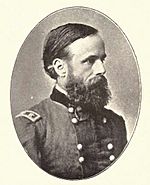Henry Larcom Abbot facts for kids
Quick facts for kids
Henry Larcom Abbot
|
|
|---|---|

Henry Larcom Abbot
|
|
| Born | August 13, 1831 Beverly, Massachusetts |
| Died | October 1, 1927 (aged 96) Cambridge, Massachusetts |
| Buried |
Mount Auburn Cemetery, Cambridge, Massachusetts
|
| Allegiance | |
| Service/ |
Union Army |
| Years of service | 1854–1895 |
| Rank | |
| Commands held | 1st Connecticut Heavy Artillery |
| Battles/wars | American Civil War |
Henry Larcom Abbot (born August 13, 1831 – died October 1, 1927) was an important military engineer and officer in the United States Army. He fought for the Union Army during the American Civil War. He became a brigadier general for his great work in engineering and artillery.
After the war, he helped study the Mississippi River. He also worked as an expert for the Panama Canal. He helped decide how the canal's locks should be built.
Contents
Early Life and Studies
Henry Larcom Abbot was born in Beverly, Massachusetts. He went to the West Point military school. He graduated in 1854, coming in second place in his class. He earned a degree in military engineering.
After West Point, Abbot worked on the Pacific Railroad Surveys in California and Oregon in 1855. A mountain in the Sierra Nevada range was named Mount Abbot in his honor in 1873.
Abbot and Captain Andrew Humphreys studied the Mississippi River. They wanted to understand how the river flowed from the Ohio River to the Gulf of Mexico. They tried to use old European formulas, but found they didn't work well.
They then created their own formula. Even though it wasn't perfect, their work was very important. It helped develop the study of hydrology (the study of water). Their research also helped create the United States Army Engineer School at Fort Totten in New York City.
Civil War Service
When the Civil War began, Abbot joined Brigadier General Irvin McDowell's army. He was hurt at the First Battle of Bull Run. Later, he became a special engineer for the Army of the Potomac.
He helped during the Peninsula Campaign and the siege of Yorktown. For his service, he was promoted to major. In 1863, he became a colonel and led the 1st Connecticut Heavy Artillery.
In May 1864, Abbot was put in charge of the artillery during the Siege of Petersburg. This was a long and difficult siege. In December 1864, President Abraham Lincoln made him a brevet brigadier general. This meant he had the rank for his brave service.
He also led a group of artillery during the successful Second Battle of Fort Fisher in January 1865. This battle was important for the Union.
After the Civil War
After the war, Abbot continued to serve in the U.S. Army Engineers. He was promoted to major in 1865. He was put in charge of the engineer battalion at Willet's Point, New York.
He helped create the army's U.S. Army Engineer School there. He also worked on many important boards. These boards helped decide how the United States would defend its coasts.
Abbot had a big impact on how coastal defenses were built. He helped develop the submarine mine system. He also pushed for using many seacoast mortars together. His idea, called the "Abbot Quad," was to fire 16 mortars at enemy ships all at once.
Working on the Panama Canal
After he retired from the army, Abbot kept working as a civil engineer. He became an expert consultant for the locks on the Panama Canal.
He joined a French company's technical committee from 1897 to 1900. When the United States took over the canal project, Abbot continued to advise them.
From 1905 to 1906, he was part of the Board of Consulting Engineers. This group was asked by Theodore Roosevelt to plan how to build the canal. Most of the board wanted a sea-level canal (without locks).
However, Abbot helped write a report that argued for a lock canal. This report convinced President Roosevelt and Secretary of War William Howard Taft to choose the lock canal plan. This was a very important decision for the canal's success.
Abbot wrote many articles and a book about the canal. He argued that a lock canal was the best choice. He also said that the wild Chagres River could be controlled and used to help operate the canal.
Retirement and Honors
Henry Larcom Abbot retired as a colonel in 1895. In 1904, he was appointed Brigadier General, retired.
He passed away on October 1, 1927, in Cambridge, Massachusetts. He is buried at Mount Auburn Cemetery.
Abbot received many honors for his work. He became a member of the National Academy of Sciences. He also received a special law degree (LL.D.) from Harvard University.
His name is one of 158 important people in Oregon's history painted in the Oregon State Capitol. Camp Abbot, a military training center in central Oregon, was named after him. It was used to train engineers during World War II. Abbot Pass in Clackamas County, Oregon, is also named for him.

